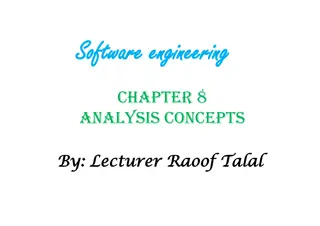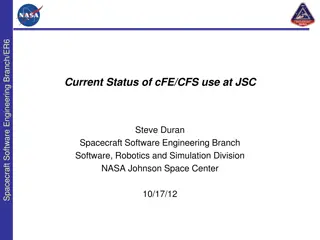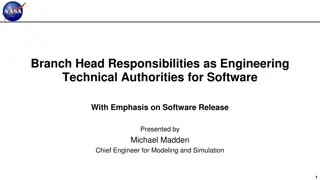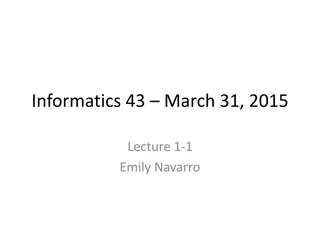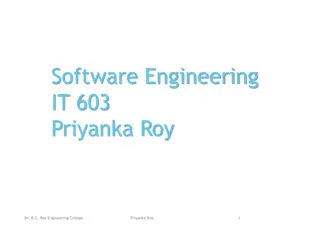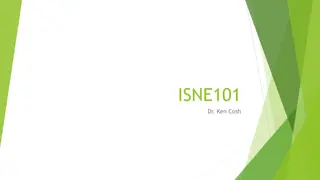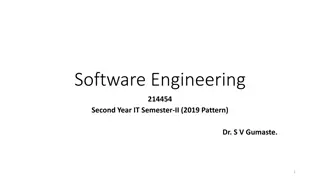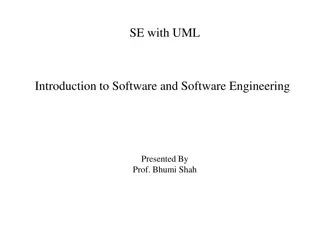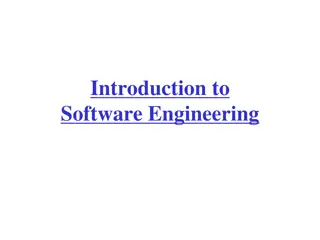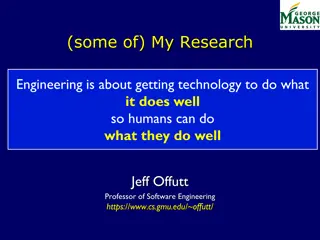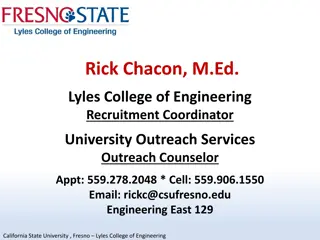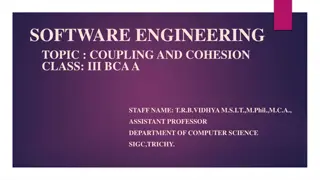
Software Engineering and Project Management Course Syllabus Fall 2021
Explore the detailed syllabus of the Software Engineering and Project Management course for Fall 2021 taught by Associate Professor Min-Yuh Day at National Taipei University. Topics include software product management, Scrum, cloud-based software, RESTful services, industry practices, and more.
Download Presentation

Please find below an Image/Link to download the presentation.
The content on the website is provided AS IS for your information and personal use only. It may not be sold, licensed, or shared on other websites without obtaining consent from the author. If you encounter any issues during the download, it is possible that the publisher has removed the file from their server.
You are allowed to download the files provided on this website for personal or commercial use, subject to the condition that they are used lawfully. All files are the property of their respective owners.
The content on the website is provided AS IS for your information and personal use only. It may not be sold, licensed, or shared on other websites without obtaining consent from the author.
E N D
Presentation Transcript
(Software Engineering) (Software Products and Project Management: Software product management and prototyping) 1101SE02 MBA, IM, NTPU (M6131) (Fall 2021) Thu 11, 12, 13 (19:25-22:10) (209) Min-Yuh Day Associate Professor Institute of Information Management, National Taipei University https://web.ntpu.edu.tw/~myday 2021-09-30 1
(Syllabus) (Week) (Date) (Subject/Topics) 1 2021/09/23 (Introduction to Software Engineering) 2 2021/09/30 (Software Products and Project Management: Software product management and prototyping) 3 2021/10/07 Scrum (Agile Software Engineering: Agile methods, Scrum, and Extreme Programming) 4 2021/10/14 (Features, Scenarios, and Stories) 5 2021/10/21 I (Case Study on Software Engineering I) 6 2021/10/28 (Software Architecture: Architectural design, System decomposition, and Distribution architecture) 2
(Syllabus) (Week) (Date) (Subject/Topics) 7 2021/11/04 (Cloud-Based Software: Virtualization and containers, Everything as a service, Software as a service) 8 2021/11/11 (Midterm Project Report) 9 2021/11/18 (Cloud Computing and Cloud Software Architecture) 10 2021/11/25 RESTful (Microservices Architecture, RESTful services, Service deployment) 11 2021/12/02 (Industry Practices of Software Engineering) 12 2021/12/09 II (Case Study on Software Engineering II) 3
(Syllabus) (Week) (Date) (Subject/Topics) 13 2021/12/16 (Security and Privacy); (Reliable Programming) 14 2021/12/23 (Testing: Functional testing, Test automation, Test-driven development, and Code reviews); DevOps DevOps (DevOps and Code Management: Code management and DevOps automation) 15 2021/12/30 I (Final Project Report I) 16 2022/01/06 II (Final Project Report II) 17 2022/01/13 (Self-learning) 18 2022/01/20 (Self-learning) 4
Ian Sommerville (2019), Engineering Software Products: An Introduction to Modern Software Engineering, Pearson. 5 Source: https://www.amazon.com/Engineering-Software-Products-Ian-Sommerville/dp/013521064X
Ian Sommerville (2015), Software Engineering, 10thEdition, Pearson. 6 Source: https://www.amazon.com/Software-Engineering-10th-Ian-Sommerville/dp/0133943038
Titus Winters, Tom Manshreck, and Hyrum Wright (2020), Software Engineering at Google: Lessons Learned from Programming Over Time, O'Reilly Media. 7 Source: https://www.amazon.com/Software-Engineering-Google-Lessons-Programming/dp/1492082791
Project Management Institute (2017), Agile Practice Guide PMI 8 Source: https://www.amazon.com/Agile-Practice-Project-Management-Institute/dp/1628251999/
Project Management Institute (2021), A Guide to the Project Management Body of Knowledge (PMBOK Guide) Seventh Edition and The Standard for Project Management 9 Source: https://www.amazon.com/Guide-Project-Management-Knowledge-PMBOK%C2%AE/dp/1628256648
Software Engineering 10
Software Engineering and Project Management Design Test Deliver Build Analyze System and Software design Integration and system testing Operation and maintenance Implementation and unit testing Requirements definition Project Management 11
Information Management Management Information Systems (MIS) Information Systems 12
Information Management (MIS) Information Systems 13 Source: Kenneth C. Laudon & Jane P. Laudon (2014), Management Information Systems: Managing the Digital Firm, Thirteenth Edition, Pearson.
Fundamental MIS Concepts Business Challenges Management Information System Business Solutions Organization Technology 14 Source: Kenneth C. Laudon & Jane P. Laudon (2014), Management Information Systems: Managing the Digital Firm, Thirteenth Edition, Pearson.
Project-based software engineering CUSTOMER Problem generates helps-with implemented-by 1 Software Requirements CUSTOMER and DEVELOPER Source: Ian Sommerville (2019), Engineering Software Products: An Introduction to Modern Software Engineering, Pearson. DEVELOPER 15
Project-based software engineering The starting point for the software development is a set of software requirements that are owned by an external client and which set out what they want a software system to do to support their business processes. The software is developed by a software company (the contractor) who design and implement a system that delivers functionality to meet the requirements. The customer may change the requirements at any time in response to business changes (they usually do). The contractor must change the software to reflect these requirements changes. Custom software usually has a long-lifetime (10 years or more) and it must be supported over that lifetime. 16 Source: Ian Sommerville (2019), Engineering Software Products: An Introduction to Modern Software Engineering, Pearson.
Product software engineering DEVELOPER 1 Opportunity inspires realizes implemented-by Product features Software DEVELOPER DEVELOPER 17 Source: Ian Sommerville (2019), Engineering Software Products: An Introduction to Modern Software Engineering, Pearson.
Product software engineering The starting point for product development is a business opportunity that is identified by individuals or a company. They develop a software product to take advantage of this opportunity and sell this to customers. The company who identified the opportunity design and implement a set of software features that realize the opportunity and that will be useful to customers. The software development company are responsible for deciding on the development timescale, what features to include and when the product should change. Rapid delivery of software products is essential to capture the market for that type of product. 18 Source: Ian Sommerville (2019), Engineering Software Products: An Introduction to Modern Software Engineering, Pearson.
Software execution models Stand-alone execution Hybrid execution Software as a service User s computer User s computer User s computer User interface Product functionality User data User interface Partial functionality User data User interface (browser or app) Additional functionality User data backups Product updates Product functionality User data Product updates Vendor s servers Vendor s servers Vendor s servers Source: Ian Sommerville (2019), Engineering Software Products: An Introduction to Modern Software Engineering, Pearson.
Product management concerns Business needs Product manager Technology constraints Customer experience 20 Source: Ian Sommerville (2019), Engineering Software Products: An Introduction to Modern Software Engineering, Pearson.
Technical interactions of product managers Product vision management Product backlog management User stories and scenarios Product manager Acceptance testing Customer testing User interface design 21 Source: Ian Sommerville (2019), Engineering Software Products: An Introduction to Modern Software Engineering, Pearson.
Software Development Life Cycle (SDLC) The waterfall model Requirements definition System and Software design Implementation and unit testing Integration and system testing Operation and maintenance 22 Source: Ian Sommerville (2015), Software Engineering, 10th Edition, Pearson.
Plan-based and Agile development Plan-based development Requirements engineering Requirements specification Design and implementation Requirements change requests Agile development Requirements engineering Design and implementation 23 Source: Ian Sommerville (2015), Software Engineering, 10th Edition, Pearson.
The Continuum of Life Cycles High Incremental Agile Frequency of Delivery Predictive Iterative Low Low High Degree of Change 24 Source: Project Management Institute (2017), Agile Practice Guide, Project Management Institute
Predictive Life Cycle Analyze Design Build Test Deliver 25 Source: Project Management Institute (2017), Agile Practice Guide, Project Management Institute
Iterative Life Cycle Refine Prototype Analyze Design Build Test Analyze Deliver 26 Source: Project Management Institute (2017), Agile Practice Guide, Project Management Institute
A Life Cycle of Varying-Sized Increments Analyze Design Build Test Deliver Analyze Design Build Test Deliver Analyze Design Build Test Deliver 27 Source: Project Management Institute (2017), Agile Practice Guide, Project Management Institute
Iteration-Based and Flow-Based Agile Life Cycles Iteration-Based Agile Requirements Analysis Design Build Test Requirements Analysis Design Build Test Requirements Analysis Design Build Test Requirements Analysis Design Build Test Requirements Analysis Design Build Test Requirements Analysis Design Build Test Repeat as needed Flow-Based Agile Requirements Analysis Design Build Test the number of features in the WIP limit Requirements Analysis Design Build Test the number of features in the WIP limit Requirements Analysis Design Build Test the number of features in the WIP limit Requirements Analysis Design Build Test the number of features in the WIP limit Requirements Analysis Design Build Test the number of features in the WIP limit Repeat as needed 28 Source: Project Management Institute (2017), Agile Practice Guide, Project Management Institute
From personas to features 1 Personas A way of representing users inspire Natural language descriptions of a user interacting with a software product are-developed-into Scenarios 2 3 Natural language descriptions of something that is needed or wanted by users inspire Stories 4 Features define Fragments of product functionality 29 Source: Ian Sommerville (2019), Engineering Software Products: An Introduction to Modern Software Engineering, Pearson.
Multi-tier client-server architecture Client 1 Client 2 Web Server Application Server Database Server Client 3 Client 30 Source: Ian Sommerville (2019), Engineering Software Products: An Introduction to Modern Software Engineering, Pearson.
Service-oriented Architecture Client 1 S1 S2 Client 2 S3 Web Server Service gateway S4 Client 3 S5 S6 Client Services 31 Source: Ian Sommerville (2019), Engineering Software Products: An Introduction to Modern Software Engineering, Pearson.
VM Container Virtual web server Virtual mail server User 1 Container 1 User 2 Container 2 Server software Application software Application software Server software Guest OS Server software Server software Guest OS Hypervisor Container manager Host OS Host OS Server Hardware Server Hardware 32 Source: Ian Sommerville (2019), Engineering Software Products: An Introduction to Modern Software Engineering, Pearson.
Everything as a service Logistics management Software as a service (SaaS) Photo editing Database Software development Cloud Platform as a service (PaaS) management Monitoring Storage Network Infrastructure as a service (IaaS) Computing Virtualization Cloud data center 33 Source: Ian Sommerville (2019), Engineering Software Products: An Introduction to Modern Software Engineering, Pearson.
Software as a service Software customers Software provider Software services Cloud provider Cloud Infrastructure 34 Source: Ian Sommerville (2019), Engineering Software Products: An Introduction to Modern Software Engineering, Pearson.
Microservices architecture key design questions What are the microservices that make up the system? How should microservices communicate with each other? How should data be distributed and shared? Microservices architecture design How should the microservices in the system be coordinated? How should service failure be detected, reported and managed? 35 Source: Ian Sommerville (2019), Engineering Software Products: An Introduction to Modern Software Engineering, Pearson.
Types of security threat An attacker attempts to deny access to the system for legitimate users An attacker attempts to damage the system or its data Integrity threats Availability threats SOFTWARE PRODUCT PROGRAM Distributed denial of service (DDoS) attack Virus DATA Ransomware Data theft Confidentiality threats An attacker tries to gain access to private information held by the system 36 Source: Ian Sommerville (2019), Engineering Software Products: An Introduction to Modern Software Engineering, Pearson.
Software product quality attributes 1 2 Reliability Availability 7 3 Software product quality attributes Security Resilience 6 4 5 Usability Maintainability Responsiveness 37 Source: Ian Sommerville (2019), Engineering Software Products: An Introduction to Modern Software Engineering, Pearson.
A refactoring process 1 2 Start Identify refactoring strategy Identify code smell 4 3 Make small improvement until strategy completed Run automated code tests 38 Source: Ian Sommerville (2019), Engineering Software Products: An Introduction to Modern Software Engineering, Pearson.
Functional testing Start 1 Unit Testing 2 4 Release Testing Feature Testing 3 System Testing 39 Source: Ian Sommerville (2019), Engineering Software Products: An Introduction to Modern Software Engineering, Pearson.
Test-driven development (TDD) 1 Start Identify new functionality 2 Identify partial implementation of functionality 3 Write code stub that will fail test Functionality complete Functionality incomplete 4 Run all automated test 7 Refactor code if required 5 Implement code that should cause failing test to pass Test failure 6 Run all All tests pass automated test 40 Source: Ian Sommerville (2019), Engineering Software Products: An Introduction to Modern Software Engineering, Pearson.
DevOps Development Deployment Support Multi-skilled DevOps team 41 Source: Ian Sommerville (2019), Engineering Software Products: An Introduction to Modern Software Engineering, Pearson.
Code management and DevOps DevOps automation Continuous integration Continuous deployment Continuous delivery Infrastructure as code Code management system Branching and merging Save and retrieve versions Recover version information Code repository Transfer code to/from developer s filestore DevOps measurement Data collection Data analysis Report generation 42 Source: Ian Sommerville (2019), Engineering Software Products: An Introduction to Modern Software Engineering, Pearson.
Marketing 43
Marketing Meeting needs profitably 44 Source: Philip Kotler and Kevin Lane Keller (2016), Marketing Management, 15th edition, Pearson.
Marketing Marketing is an organizational function and a set of processes for creating, communicating, and delivering value to customers and for managing customer relationships in ways that benefit the organization and its stakeholders. 45 Source: Philip Kotler and Kevin Lane Keller (2016), Marketing Management, 15th edition, Pearson.
Marketing Management 46
Marketing Management Marketing management is the art and science of choosing target markets and getting, keeping, and growing customers through creating, delivering, and communicating superior customer value. 47 Source: Philip Kotler and Kevin Lane Keller (2016), Marketing Management, 15th edition, Pearson.
Marketing Management Understanding Marketing Management 1 2 Capturing Marketing Insights 3 4 Connecting with Customers Building Strong Brands 5 6 7 8 Creating Value Delivering Value Communicating Value Conducting Marketing Responsibly for Long-term Success 48 Source: Philip Kotler and Kevin Lane Keller (2016), Marketing Management, 15th edition, Pearson.
Software Engineering 49
Software Engineering and Project Management Design Test Deliver Build Analyze System and Software design Integration and system testing Operation and maintenance Implementation and unit testing Requirements definition Project Management 50



